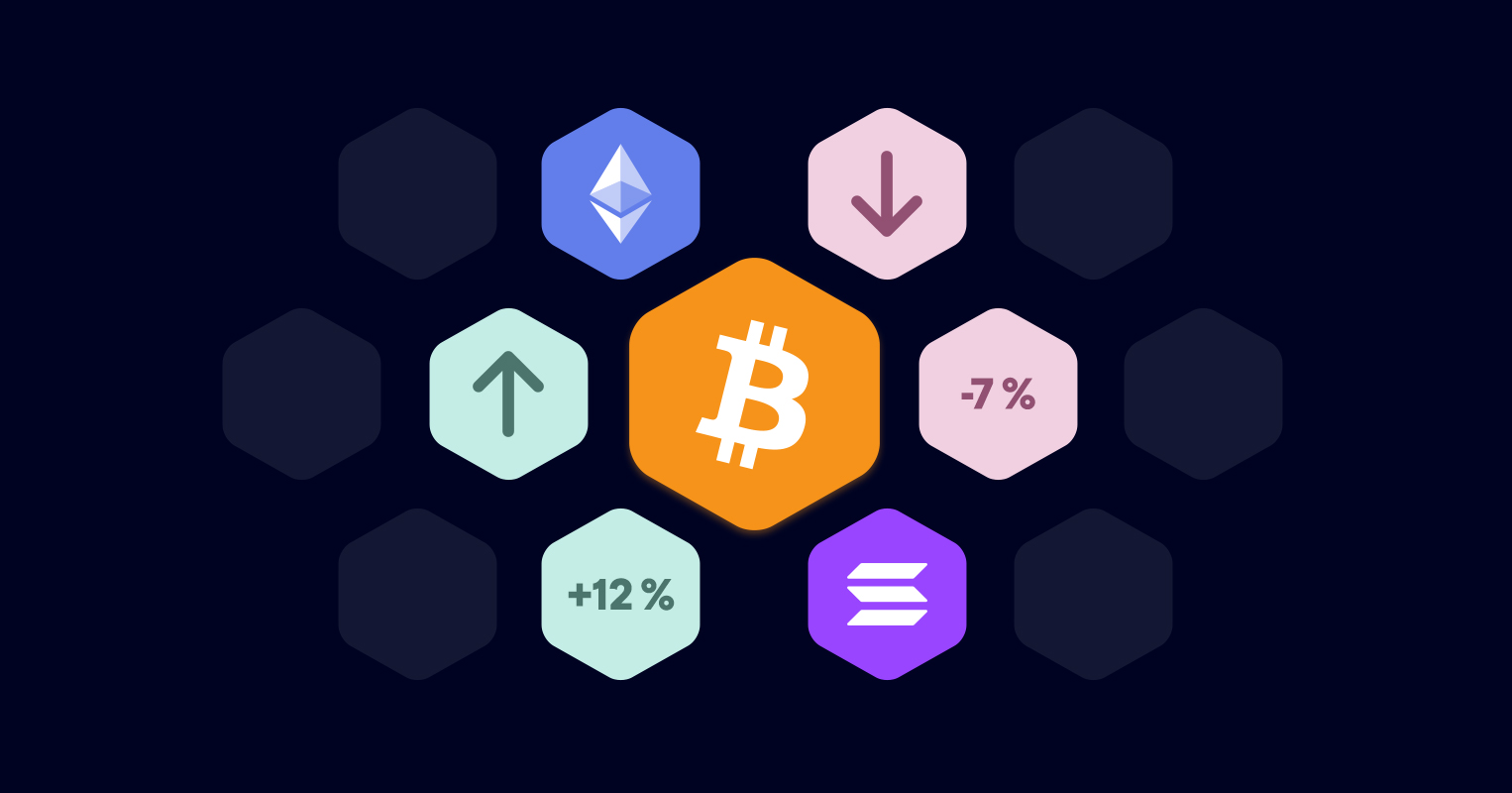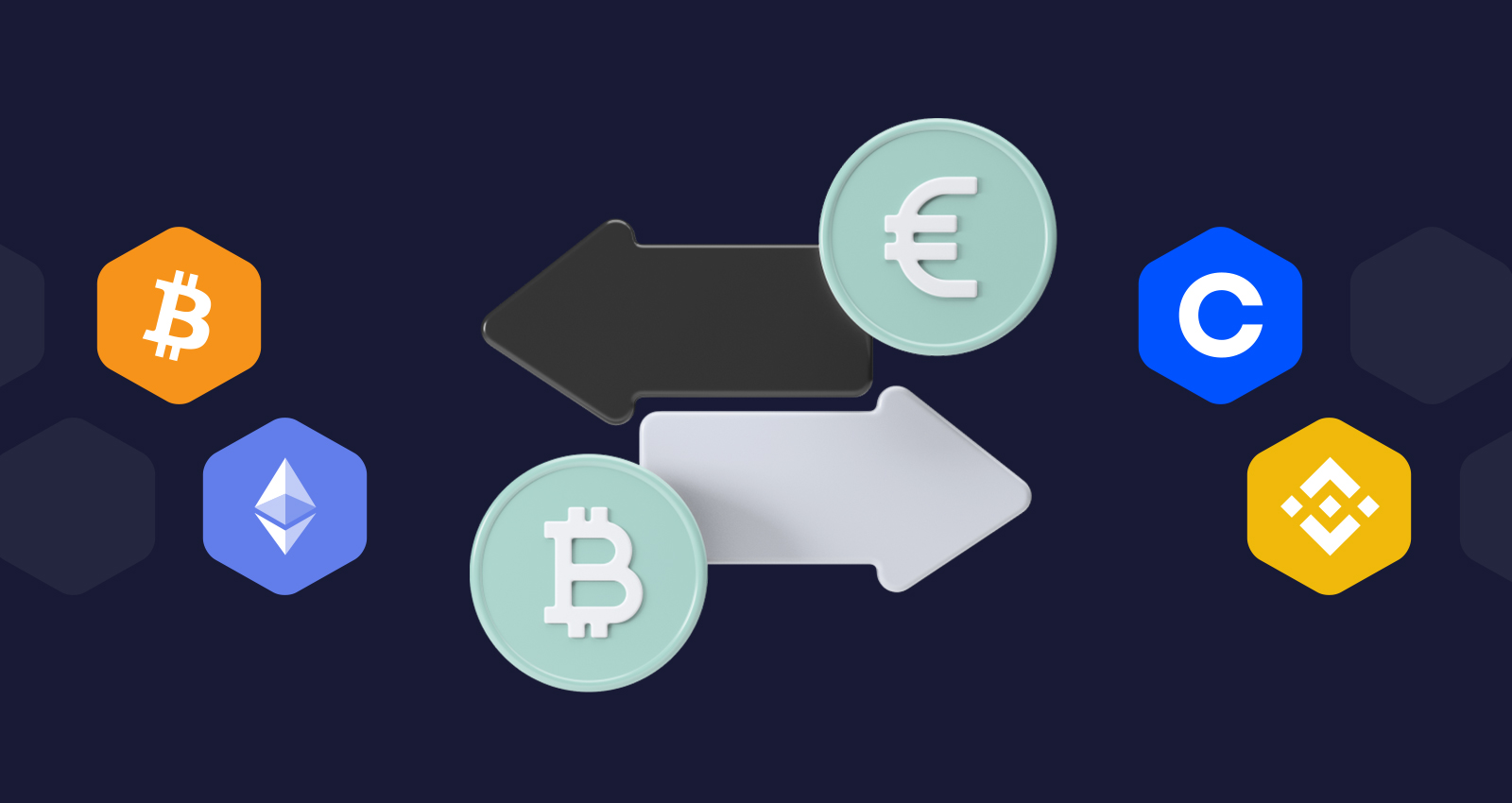
Crypto prices and market trends
Table of contents
This overview provides a quick snapshot of key prices and market trends for the most popular cryptocurrencies.
| Cryptocurrency | Price | All-time high | Difference | 24 h | 30 days | 1 year |
|---|---|---|---|---|---|---|
Bitcoin | $88,572.00 | $126,080.00 | -29.77% | +0.96% | +2.01% | -4.47% |
Ethereum | $2,972.44 | $4,946.05 | -39.92% | -0.28% | +4.74% | -11.22% |
BNB | $864.78 | $1,369.99 | -36.86% | +1.18% | +3.97% | +23.48% |
XRP | $1.87 | $3.65 | -48.78% | +0.082% | -9.16% | -7.96% |
Solana | $125.85 | $293.31 | -57.12% | +1.08% | -1.41% | -33.66% |
Dogecoin | $0.12 | $0.73 | -83.20% | -1.14% | -11.01% | -60.57% |
Cardano | $0.35 | $3.09 | -88.69% | -1.66% | -9.94% | -58.61% |
Bitcoin Cash | $599.37 | $3,785.82 | -84.18% | +0.46% | +15.22% | +36.97% |
Chainlink | $12.40 | $52.70 | -76.47% | -0.65% | +1.42% | -38.91% |
Zcash | $525.55 | $3,191.93 | -83.55% | -1.69% | +43.74% | +799.96% |
Hyperliquid | $25.88 | $59.30 | -56.36% | +0.29% | -16.78% | +0.060% |
Sui | $1.44 | $5.35 | -73.01% | +0.48% | +4.18% | -65.27% |
Avalanche | $12.48 | $144.96 | -91.39% | -0.049% | -4.40% | -64.57% |
Hedera | $0.11 | $0.57 | -80.54% | -1.27% | -17.33% | -58.74% |
Uniswap | $5.89 | $44.92 | -86.91% | -1.84% | +5.97% | -55.65% |
Polkadot | $1.81 | $54.98 | -96.71% | -0.82% | -11.90% | -72.62% |
Aave | $149.31 | $661.69 | -77.44% | -0.91% | -10.09% | -51.91% |
NEAR Protocol | $1.51 | $20.44 | -92.62% | -1.95% | -9.40% | -69.75% |
Ondo | $0.37 | $2.14 | -82.54% | -1.22% | -19.79% | -72.04% |
Kaspa | $0.044 | $0.21 | -78.91% | -0.043% | -16.15% | -62.24% |
What influences cryptocurrency prices?
Supply and demand
Market psychology (emotions, trends, sentiment)
Technological developments and upgrades
Usage and adoption of the cryptocurrency
Significant events and news
Political and economic conditions
Trading bots (arbitrage trading)
Long and short positions in the market
Note: Past price performance is never a guarantee of future results. The figures should never be used as the sole basis for decisions and are intended only to support comparisons.
Sectors: what types of cryptocurrencies are there?
There’s a wide range of coins, tokens, and cryptocurrencies with diverse use cases and goals. However, most cryptocurrencies can be grouped into the following sectors:
Currency
Smart contract platform
Decentralized Finance (DeFi)
Gaming and Metaverse
Stablecoins
Scaling solutions
Currency
Smart Contract Platform
Decentralized Finance (DeFi)
Gaming and Metaverse
Stablecoins
Scaling solutions

Comparing cryptocurrencies
There are thousands of coins and tokens, but only a few are likely to stand the test of time and find real-world applications beyond pure speculation. To compare cryptocurrencies, the following fundamental criteria are helpful:
Use case: It’s important to understand the specific purpose a cryptocurrency was created for and the problems it seeks to address. Some cryptocurrencies are designed for use in particular industries or applications, while others are intended as general means of payment.
Technology: Cryptocurrencies are built on different technologies, each offering unique features and functionalities. Understanding a cryptocurrency’s underlying technology is crucial for grasping how it works and what advantages it might provide.
Market data and metrics: When comparing cryptocurrencies, you can look at various metrics and market data such as market capitalization, trading volume, total value locked (TVL), inflation rate, return on investment (ROI), percentage off the all-time high, and many more.
Decentralization and censorship resistance: The level of decentralization is particularly important in cryptocurrencies and blockchains. The more participants, developers, and validators involved in a network, the more decentralized, censorship-resistant, and secure it is.
Developers and community: A blockchain or cryptocurrency relies heavily on attracting developers who actively contribute to its ongoing development. A strong community of developers, users, and supporters is essential for the success of any cryptocurrency.
You’ll find more information and detailed explanations in our checklist for analyzing and evaluating cryptocurrencies.

Buying cryptocurrencies
Where can I buy cryptocurrencies?
The best way to buy cryptocurrencies is through a crypto exchange or broker. These trading platforms specialize in buying and selling cryptocurrencies and are usually easy to use. Banks and traditional stock exchanges usually offer limited or no options for buying cryptocurrencies. You’re sure to find the right exchange for your needs in our exchange comparison.
How can I buy cryptocurrencies?
Once you’ve chosen an exchange, buying cryptocurrencies is generally straightforward and involves similar steps across most platforms:
Register with the crypto exchange
Complete verification and KYC (upload documents and ID)
Deposit euros via bank transfer or other payment methods
Exchange your deposited euros on the platform for the cryptocurrency of your choice
Tips for buying cryptocurrencies
If you’re a beginner, choose an exchange that’s suitable for newcomers
Pay attention to reasonably low fees when selecting an exchange
Exchanges based in Germany (or Europe) usually offer more security
Use a strong password and two-factor authentication to secure your account
Avoid storing large amounts of crypto on an exchange — use a crypto wallet instead.
Which cryptocurrencies should I buy?
In general, cryptocurrency prices are highly volatile, making them a risky and highly speculative asset class. The choice of which cryptocurrencies to buy also depends heavily on your personal risk tolerance. Established cryptocurrencies like Bitcoin and Ethereum are often good starting points (not financial advice). If you’re willing to take on more risk, you could explore altcoins — smaller, alternative cryptocurrencies.
One important rule applies: Before buying any cryptocurrency, you should educate yourself using a variety of sources and learn how to analyze and evaluate cryptocurrencies. If you decide to invest, always keep the high risk of losses in mind. Many experts recommend allocating only a small portion of your capital to buying cryptocurrencies.
When is the right time to buy cryptocurrencies?
Timing the perfect moment to buy is difficult — markets fluctuate, and short-term predictions are uncertain. Instead of speculating, you could spread your risk and invest long-term with a monthly savings plan. This way, you benefit from the cost-average effect, which helps smooth out market volatility. You can use our Bitcoin DCA Calculator to see how regular purchases could impact your investment.
Risks of cryptocurrencies
Risks when paying with cryptocurrencies
No legal safeguards: When transacting with cryptocurrencies, there’s no bank or central authority that can reverse a transaction sent to the wrong address, for example. You’re fully responsible for managing your own funds, with all the benefits and risks that come with it.
Your transactions are publicly visible: A blockchain and its transactions are transparent and viewable by anyone. While your crypto address is anonymous, it’s still possible for your identity to be linked to it—for instance, if you buy crypto on an exchange or use it to pay in an online shop.
Risks when investing in cryptocurrencies
Personal responsibility: If you store your cryptocurrencies yourself in a wallet, you don’t have the same protections as with a bank account. A small mistake, such as entering the wrong address when sending or receiving funds, can result in the loss of your coins. Storing your coins on exchanges also carries certain risks.
High volatility: Cryptocurrency prices can fluctuate massively, and the value of your coins can rise or fall dramatically in a short time. Handling such extreme volatility can also be mentally stressful.
Fear of missing out: “Fear of missing out,” or “FOMO,” describes the anxiety of missing a profitable opportunity. While the crypto market frequently presents exciting chances, don’t let emotions push you into impulsive decisions. Take your time and gather information from multiple sources.
Scams and pump-and-dump coins: A significant number of cryptocurrencies were created purely to generate high returns for founders or early investors. Scams often involve artificially inflating prices through hype, only for them to collapse once early investors sell off their holdings. Always stay skeptical and learn how to analyze cryptocurrencies carefully.
About the author
Hi, I'm Philipp. 👋
Founder coinbird.com
With over 15 years of experience in the IT sector, I love building easy-to-use digital products that actually help people. In 2017, I fell down the Bitcoin rabbit hole and gradually realized that the crypto world lacked simple, user-friendly tools for everyday people. That’s why I created coinbird.com – to make crypto easier to understand, more accessible, and transparent.
LinkedIn
